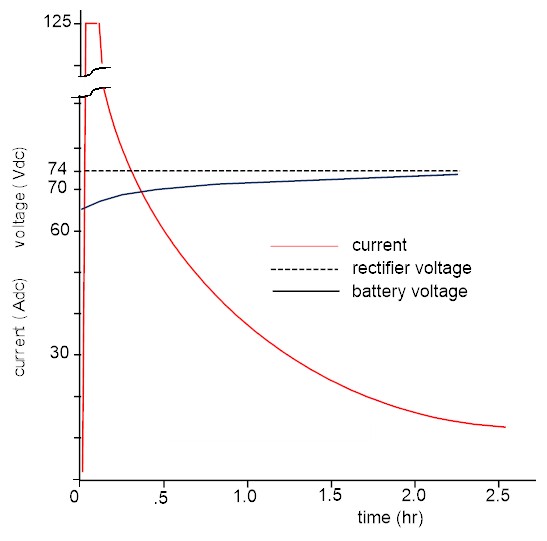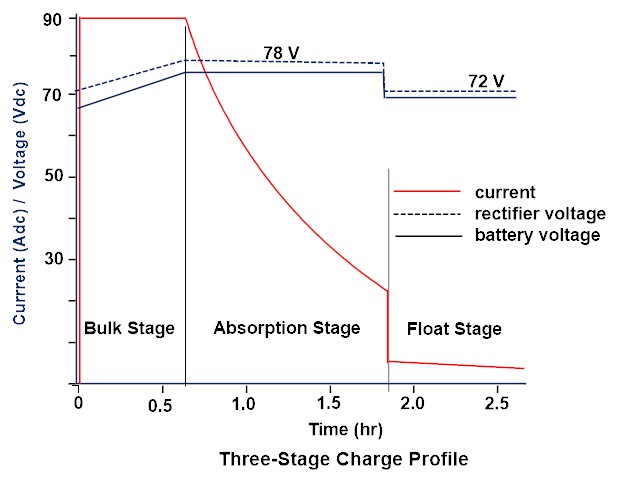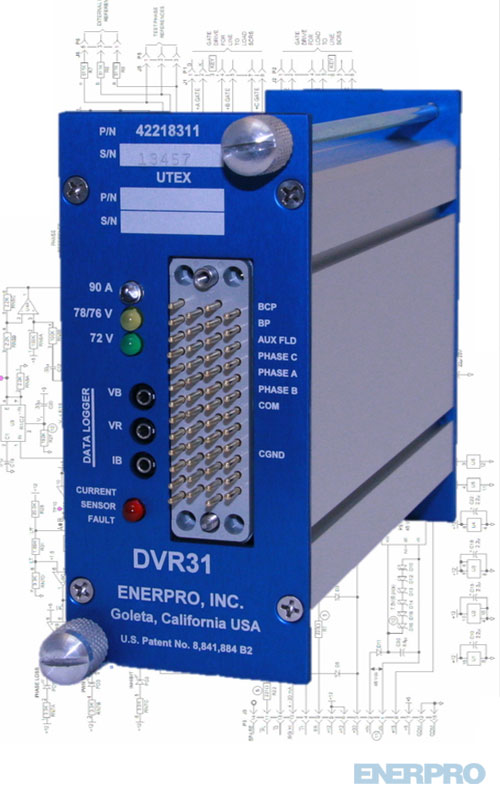DVR31 3-Stage Charge Auxiliary Generator Regulator
Enerpro’s DVR31 3-stage charge auxiliary generator voltage regulator module is a direct plug-in replacement for the DVR301 1-stage charge auxiliary generator voltage regulator modules used in EMD locomotives.
The DVR31 utilizes a battery current sensor to provide a battery manufacturer recommended 3-stage battery charge profile resulting in longer battery life, reduced dead won’t starts, and reduced water consumption. The DVR31 is compatible with flooded lead acid (FLA) and valve regulated lead-acid (VRLA) batteries.
Key Features
- Direct Replacement for DVR301
- Three-stage Battery Charging
- Longer Battery Life
- Reduced Failure to Start Events
- Faster Charging
- Reduced Water Consumption
- Simple Installation
- Compatible with Flooded Lead Acid, and Valve
Regulated Lead Acid
Technical Details
Single-Stage Charging with the DVR301 Module
Operators report that locomotives that are shut down and restarted multiple times per day due to fuel cost or pollution regulations experience a premature loss of battery capacity. This problem is caused by the one-stage charge profile provided by the conventional DVR301 auxiliary generator regulator.
With one-stage charging, as shown in the voltage and current vs. time profile in Figure 1, the auxiliary generator voltage is regulated to a constant 74 Vdc (typical). Charging current is limited by the cable resistance of about 20 mΩ between the generator and battery augmented by a 50 mΩ resistor, bringing the total resistance to about 70 mΩ. With the generator at a constant 74 V, the battery terminal voltage at 125 A is about 74 V – 125 A * 0.07Ω = 66 V. As charge proceeds, the charging current decreases and the battery voltage increases. After several hours of operation with the engine running, the current may have fallen to 30 A which results in a battery voltage of 74 V – 30 A * 0.07 Ω = 72 V. If the engine is shut down at this time, the final charging voltage will be 6 V less than the 78 V (2.44 Volts per cell) required for a complete recharge.

Figure 1 – One-Stage Charge Profile
Battery manufacturers recommend applying 2.44 Volts per cell, or 78 Vdc for a 32 cell battery, during recharge for a time sufficient to remove the amorphous lead sulfate (PbSO4) that accumulated on the plates during the previous discharge. If the lead sulfate is not completely removed before charging is terminated by engine shut down, the sulfate coating on the plates thickens and crystallizes, becoming less conductive with each charge-discharge cycle. The result is that the battery progressively loses its ability to accept charge – a process called sulfation.

Three-Stage Charge Profile
As shown in Figure 2, the three-stage charge profile produced by the DVR31 regulates the first, or bulk stage, current to about 20% of the battery’s capacity per manufacturers’ recommendations. In the second, or absorption stage, the rectifier voltage is regulated to 78 V. This elevated voltage converts the maximum amount of active battery material while equalizing the charge in each cell, thus minimizing sulfation and capacity loss. In the third, or float stage, the DVR31 maintains voltage regulation but at a lower setpoint (72 V). In this mode, the battery draws only a little more than the self-discharge current required to maintain full charge.
Figure 2 – Three-Stage Charge Profile
The result is negligible loss of electrolyte in the float stage. This benefit is especially important with Valve Regulated Lead Acid (VRLA) batteries.
Bulk Stage
Upon engine start, the DVR31 commands a bulk stage current of 90 amps. The battery behaves as a capacitor in that the constant charging current results in battery voltage increasing with time. The bulk stage ends when the voltage reaches the 78 V limit. When charging from a low initial state of charge, approximately 80% of capacity is stored in the bulk stage. The characteristic response of the voltage and current regulators provide the transition between the bulk and absorption stages.
Absorption Stage
With voltage fixed at 78 V, the battery current in the second stage decays approximately exponentially with time from the initial bulk stage current until one of two absorption stage termination criteria are met. These criteria are:
- either the steady-state absorption stage current falls to typically 25 A, or
- the second derivative of battery charge, d2Q/dt2, falls below a preset threshold.
Typically, 95% of battery capacity is stored if the engine runs long enough for the charge process to reach the end of the absorption stage.
Forcing the absorption-to-float transition to occur as a function of the second derivative of charge (a patent-pending methodology) provides a form of inherent temperature compensation. Current in this stage decreases less rapidly with increased battery temperature. As a result, higher temperature causes the charge limit to be reached in shorter time. This is what would happen if the absorption stage voltage were to be decreased with increasing temperature. Transitioning from the absorption to the float stage as a function of the second derivative of charge also assures that a shorted cell or other battery defect will not result in continuous operation at elevated voltage.
A comparator monitors the battery current feedback signal and forces the float transition when the current is less than 25 A. A voltage-to-frequency converter and microcontroller perform the d2Q/dt2 computation.
For VRLA batteries the absorption stage voltage is reduced to 76 V per manufacturers’ typical recommendations.
Float Stage
The voltage regulator holds the rectifier voltage at 72 V (2.22 Vpc) as a result of a change in the voltage command from 78 V to 72 V when one of the two absorption/float transition criteria is met. This allows the battery to draw the required self-discharge current. This voltage is maintained until engine stops. Electrolyte loss is negligible in the float stage.
DVR31 Functional Description
Field Circuit Breaker Connection
The DVR31 trips the external 15A field circuit breaker on overvoltage at 118 V rectifier voltage to prevent damage to the control circuit and equipment connected to the rectifier bus. The DVR31 is capable of tripping the original circuit breaker installed on the locomotive; no new hardware is required.
DVR31 Circuitry
The DVR31 contains the following circuits:
- Low voltage regulated power supply
- PWM field chopper controller and transistor
- Voltage and current error amplifiers
- Rectifier voltage, battery voltage, and battery current scaled outputs for data logger connections
- Loss of current sensor indicator LED
- Charge state indicator LEDs
Low Voltage Power Supply
The low voltage power supply provides +12 V control power to the circuit board via a regulated buck switch mode converter connected to the locomotive battery via an external 5.7 ohm resistor. The +5 V control reference is generated by the PWM IC.
Voltage and Current Regulation
Separate voltage and current control loops provide regulation. Current is limited to the commanded value when charging current exceeds the current setpoint. Similarly, voltage is limited when the generator voltage exceeds the voltage setpoint. The absorption stage voltage command is adjusted by a board-mounted potentiometer. Voltage is limited to the absorption level of 78 V after the bulk stage current reaches the current setpoint. After the absorption/float stage transition, the voltage command is reduced to produce the 72 V float voltage.
Shorted PWM Transistor Protection
At high engine speed, the auxiliary generator will produce dangerously high voltage if the PWM transistor shorts or is turned on continuously due to a component failure. In this event, an over-voltage comparator trips the external breaker if the auxiliary generator voltage exceeds the over-voltage trip threshold. This threshold is provisionally set at 118 V.
Loss of Current Feedback Protection
An open circuit signal or loss of power to the current sensor causes the current signal input to the DVR31 to default to a higher than normal level. A circuit on the control board senses this condition and forces the regulator into the 72 V float mode while indicating a current sensor fault on the front panel after a brief (approximate 10 second) dead time
Enable/Inhibit
No computer interface is required to enable the DVR31. As described above, the DVR31 is directly powered from the locomotive battery and commences the bulk stage charge immediately after the engine starts. The DVR31 shuts down and resets each time the engine is turned off.

